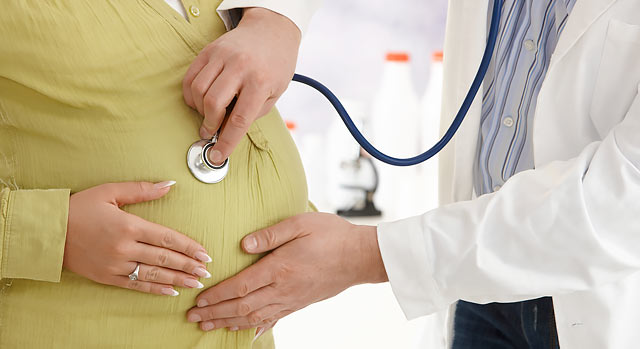What to Expect in the Last Three Months of Pregnancy
In the last three months of pregnancy, the fetus will be about 15 inches long and weigh about three pounds. At this stage, most have begun to respond to light and sound and the fetus can suck its thumb and cry. It exercises by kicking and stretching. As your belly gets bigger, you may lose your sense of balance, making falls a possibility, so be careful. You may feel false labor contractions, also called Braxton Hicks contractions. This is normal, but call your physician if you have more than five of these contractions in an hour. Your sleep may change because your baby may be moving a lot at night.
Weeks 28 to 32
There are many theories about what you can share with your baby while he or she is still in the womb. Some scientists believe that some type of prenatal communication with your baby may give you a head start in the child-parent bonding experience.
By the beginning of the third trimester, the fetus should have developed the ability to hear. Your baby will be able to hear music and the sound of your voice. Your baby will be getting used to the sound of your voice — and most likely its father’s voice — in normal conversation. That’s why many newborns seem to recognize their parents. They can distinguish types of sounds, loud or quiet noises and different pitches.
If your baby is very active inside you during a specific period of the day, try turning on some soothing music. If that doesn’t help calm your baby, rock in a rocking chair for 15 minutes. This combination of music and motion may soothe your baby.
By now, you have probably already experienced the sensation of your baby kicking and turning inside you. He or she can feel you as well. As you rub your belly, you may be able to identify parts of your baby. A long smooth area is likely to be the fetus’s back. Lumpy areas are its arms and legs. A firm round area is most likely the head. A small bump is probably a hand, foot or elbow. If you gently massage the lump, the baby may pull back. Stroking your abdomen or playing with a little lump in your belly can be a wonderful bonding experience for you, the baby’s father and your older children.
Weeks 33 to 36
During weeks 33 to 36, the baby’s brain continues to grow rapidly. The bones of the head, however, remain soft and flexible to make it easier for the baby to fit through the birth canal. The baby is too big to move around very much, but can kick strongly. You may even notice the shape of an elbow or heel against your abdomen. The fetus should now be about 18 inches long and weigh about five pounds. You may have noticed a little shortness of breath as the baby crowds your lungs. The baby may also be crowding your stomach, so try eating five or six smaller meals during the day.
Weeks 37 to 40
Between 37 and 40 weeks, your baby should be full term, weigh six to nine pounds and measure between 19 and 21 inches in length. Its lungs should be mature and ready to function on their own. The fetus fills all the space in your uterus, and will begin to drop into a head-down position that rests lower in your abdomen. This is called “lightening.” You may notice your belly button is sticking out and your cervix begins to dilate. Your breathing should be easier once the baby drops, and the pressure on your lungs is relieved. However, you may find that you’ll have to urinate more often, as the baby presses on your bladder.
By now, your due date is approaching and you should be seeing your caregiver every week to check for signs of labor. Just remember that your due date is a target, not a guarantee. In 85 percent of pregnancies, babies are born within a two week window around their due date, while only five percent are born on their actual due date.
Preparing for Labor
Labor is the interaction of your uterus, cervix and hormones. It begins when your body releases hormones that help soften the cervix and tighten the muscles of the uterus. This experience feels different to every pregnant woman. There are three stages of labor:
- The onset of true labor contractions until the cervix is fully dilated
- Continued full dilation of the cervix until the baby is born
- Expulsion of placenta or afterbirth.
True vs. False Labor
There is 'true' labor and there is 'false' labor. You may begin to experience false labor up to a month before the end of your pregnancy. False labor can include insufficient contractions of the uterus or painful spasms of the intestines, bladder and abdomen wall muscles. Here are some ways you can tell the difference between false labor and true labor. Remember, this is only a guide, so be sure to talk with your physician to decide what you should do
True Labor — You will know you are experiencing true labor if your contractions become regular, longer, closer together and stronger. In addition, when you walk, the contractions should feel strong and they should not go away when you lie down. The pain you feel should start in your lower back and radiate to the front.
False Labor — Contractions are irregular and short, they do not get closer together and they do not grow stronger. Walking may not make false labor contractions feel stronger and they may go away if you lie down. You will probably feel the pain in the upper uterus and groin.
Going to the BirthPlace at St. Mary's
Make sure you have your bags pre-packed and ready to go to the BirthPlace at St. Mary's Regional Medical Center well before labor. At the hospital, you will be given a private room and a nurse from will be assigned to you. As labor becomes more active, your nurse will be there to support you and answer questions. Your physician and nurse will do pelvic exams to check the progress of your cervical effacement and dilation, as well as check the baby’s position. This is your special day, and we want to help make it is as comfortable as possible. Please let us know how we can best help you.
Hospital Bag Checklist
Use this checklist to help pack your bag:
For Mom
- Toiletries
- Pillow
- Prenatal vitamins
- Robe
- Socks
- Flip flops or slippers
- Loose pajamas
- Going home outfit
- Nursing tanks
- Nursing/maternity bra
- Maternity pads
- Comfortable underwear
- Nursing pillow (if breastfeeding)
- Nursing cover (if breastfeeding)
- Phone and charger
- Driver’s license
- Insurance information
For Baby
- Sleepers (3-5)
- Onesies (3-5)
- Swaddling blankets (2)
- Burp cloths
- Baby mittens
- Newborn diapers
- Baby wipes
- Car seat (install base before baby arrival)
- Pacifiers (if using)

